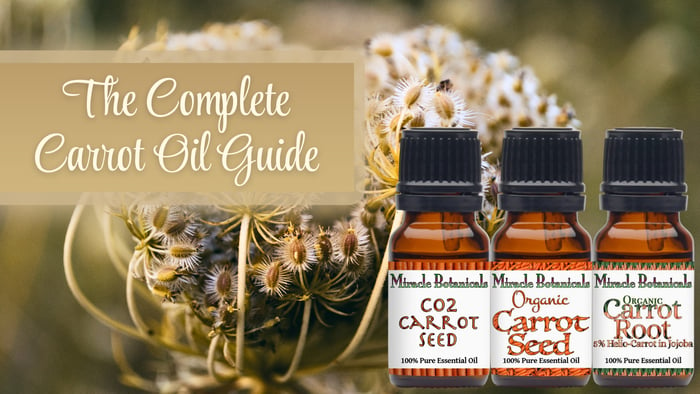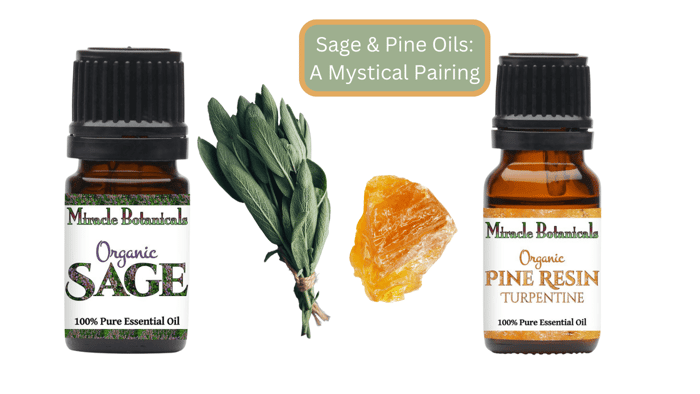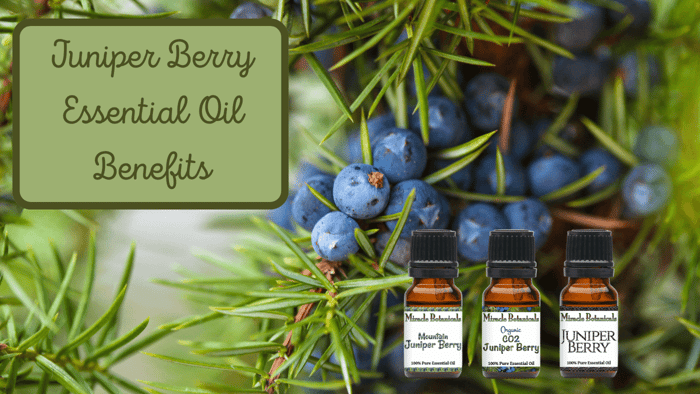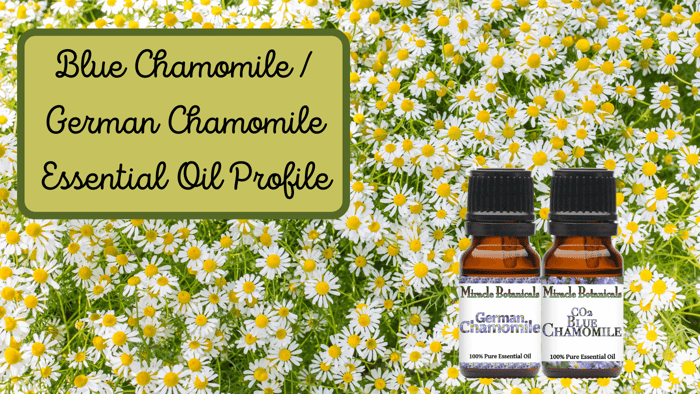Table of Contents
- Understanding the Botanical Source: Daucus carota
- Carrot Seed Essential Oil: The Classic Skin Rejuvenator
- Carrot Root CO2: The Nourishing Antioxidant Powerhouse
- Carrot Seed Essential Oil (CO2 Extracted): The Full-Spectrum Option
- Comparative Analysis: Which Oil for Which Purpose?
- Synergistic Blending: Using All Three Together
- Conclusion: The Power of Informed Choice
- FAQs
The Complete Guide to Carrot Oils: Comparing Carrot Seed Essential Oil (Steam-Distilled & CO2) and Carrot Root Oil
Discover the remarkable therapeutic potential of three distinct carrot-derived oils and how each offers unique benefits for skin rejuvenation, cellular regeneration, and holistic wellness.
When it comes to botanical skincare, few plants rival the regenerative power of oils derived from Daucus carota – the wild carrot plant. Yet despite sharing a common botanical source, carrot seed essential oil (both steam-distilled and CO2 extracted) and carrot root oil are fundamentally different in their extraction methods, phytochemical profiles, and therapeutic applications.
In this comprehensive guide, we'll explore the science behind these three carrot-derived oils, examining their unique extraction processes, chemical constituents, mechanisms of action, and evidence-based benefits for skin health and overall wellness.

Understanding the Botanical Source: Daucus carota
Daucus carota, commonly known as wild carrot or Queen Anne's Lace, is a biennial plant native to Europe and southwestern Asia. While you may know it as the orange vegetable in your kitchen, the plant used for therapeutic oil production is often a different variety grown specifically for its seeds and medicinal properties rather than for culinary use.
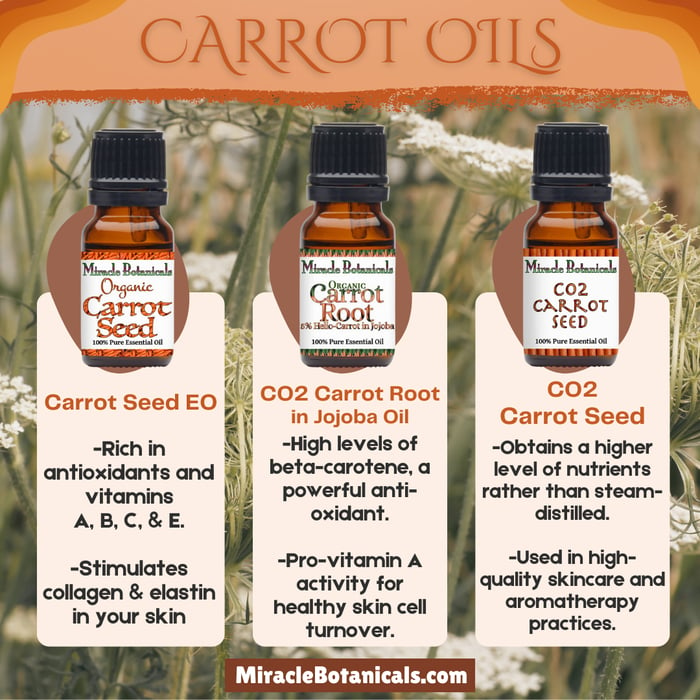
For commercial essential oil and extract production, cultivated Daucus carota plants are used - grown specifically for therapeutic applications.
While both food carrots and therapeutic oil-producing carrots share the same genus (Daucus) and species (carota), they are different cultivated varieties.
The sweet, tender carrots bred for eating have been selected for flavor and texture, while medicinal varieties have been cultivated for their therapeutic compound content.
Why these oils are unique:
The seeds and roots contain vastly different phytochemical profiles, which is why these oils serve distinct therapeutic purposes. Seeds are rich in volatile sesquiterpenes and aromatic compounds ideal for essential oil production, while roots contain high concentrations of fat-soluble carotenoids and vitamins that make them exceptional for skin nourishment.
The plants grown for oil extraction prioritize medicinal compound content over taste, sweetness, or culinary texture - resulting in more potent therapeutic extracts
Carrot Seed Essential Oil: The Classic Skin Rejuvenator
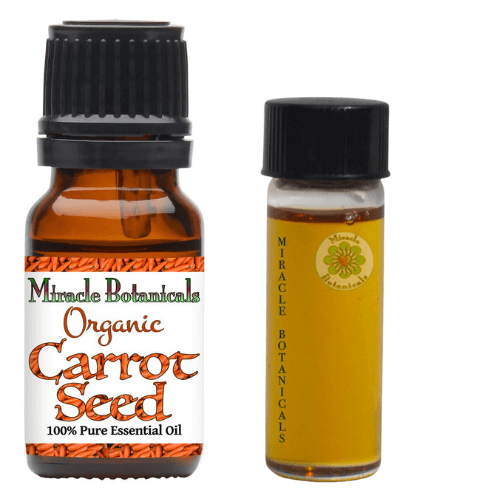
Extraction Method
Steam-distilled carrot seed essential oil is produced through hydrodistillation, a traditional extraction method that has been used for centuries. During this process:
- Dried carrot seeds are placed in a distillation chamber
- Steam passes through the plant material at temperatures between 100-120°C
- The steam volatilizes the aromatic compounds in the seeds
- The steam-oil mixture is condensed and collected
- The essential oil separates from the water (hydrosol) and is collected
This method selectively captures volatile, steam-distillable compounds while leaving behind heavier molecules and heat-sensitive constituents.
Chemical Composition
Steam-distilled carrot seed essential oil contains a complex array of volatile compounds, with the specific composition varying based on geographic origin, harvest time, and distillation parameters. Key constituents include:
Primary Components:
- Carotol (30-70%): A sesquiterpene alcohol responsible for much of the oil's distinctive aroma and therapeutic properties
- Daucol (5-15%): Another sesquiterpene alcohol with skin-regenerative properties
- β-Bisabolene (2-10%): A sesquiterpene with anti-inflammatory activity
- Geranyl acetate (1-8%): An ester contributing to the sweet, floral notes
- Sabinene, limonene, and other monoterpenes (trace amounts): Provide antimicrobial and antioxidant effects
Secondary Constituents:
- Asarone (trace amounts): A phenylpropanoid with potential cellular benefits
- Various aldehydes, ketones, and additional sesquiterpenes
Therapeutic Properties & Mechanisms of Action
Skin Rejuvenation & Anti-Aging: The high carotol content exhibits significant antioxidant activity, neutralizing free radicals that contribute to premature aging. Studies suggest that sesquiterpene alcohols like carotol and daucol may stimulate fibroblast activity, promoting collagen synthesis and improving skin elasticity.
Cellular Regeneration: Carrot seed oil has been traditionally used to support skin cell turnover. The oil's complex sesquiterpene profile may enhance keratinocyte differentiation, promoting healthy skin renewal and potentially reducing the appearance of scars and hyperpigmentation.
Balancing & Toning: The oil demonstrates both astringent and emollient qualities, making it valuable for balancing various skin types. Its toning properties may help improve skin texture and minimize the appearance of enlarged pores.
Hepatic Support: In traditional European herbalism, carrot seed oil was valued for its potential liver-supporting properties, though modern scientific validation of these effects is limited.
Aromatherapy Applications
Steam-distilled carrot seed essential oil has a distinctive sweet, earthy, and slightly woody aroma with herbaceous undertones. In aromatherapy, it's used for:
- Grounding and centering during meditation
- Supporting mental clarity and focus
- Balancing emotions during times of stress
- Creating earthy, root-chakra blends
Safety Considerations
Generally regarded as safe when properly diluted (typically 1-3% in carrier oils for topical use). Should be avoided during pregnancy without professional guidance. Always perform a patch test before widespread use.
Carrot Root CO2: The Nourishing Antioxidant Powerhouse
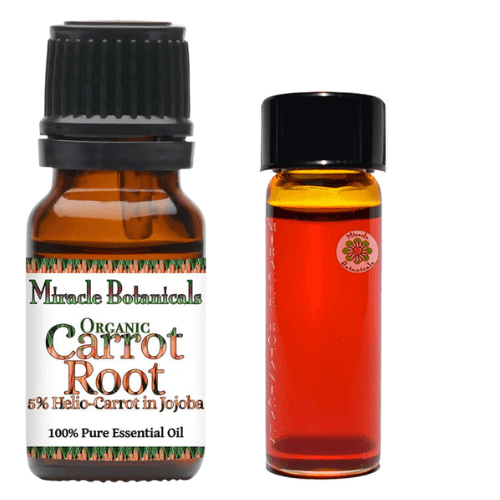
Extraction Method
Unlike carrot seed essential oil, carrot root oil is not a true essential oil but rather an oleoresin extract obtained through supercritical CO2 extraction.
CO2 Extraction (Supercritical Fluid Extraction):
- Dried and ground carrot root is placed in an extraction vessel
- Supercritical CO2 (maintained at specific temperature and pressure) acts as a solvent
- The CO2 selectively dissolves lipophilic (fat-soluble) compounds from the root
- Pressure is reduced, causing the CO2 to return to gaseous state
- The extracted oleoresin remains, free from solvent residues
This method operates at lower temperatures (typically 95-122°F), preserving heat-sensitive nutrients that would be destroyed by steam distillation. The result is a concentrated extract rich in fat-soluble carotenoids, vitamins, and other phytonutrients directly from the carrot root.
Chemical Composition
Carrot root oil has a dramatically different chemical profile compared to seed-derived oils, rich in fat-soluble nutrients rather than volatile aromatic compounds:
Primary Components:
- β-Carotene (pro-vitamin A): The dominant carotenoid, giving the oil its characteristic orange hue
- α-Carotene: Additional pro-vitamin A activity
- Lycopene: A powerful antioxidant carotenoid
- Lutein and zeaxanthin: Carotenoids with photoprotective properties
- Vitamin E (tocopherols): Fat-soluble antioxidants
- Fatty acids: Depending on extraction method, may include oleic, linoleic, and palmitic acids
- Phytosterols: Plant compounds with skin-soothing properties
Note: The exact composition varies significantly based on carrot variety, growing conditions, and extraction method. CO2 extracts tend to have higher concentrations of carotenoids compared to oil infusions.
Therapeutic Properties & Mechanisms of Action
Powerful Antioxidant Protection: β-Carotene is one of nature's most potent antioxidants, capable of quenching singlet oxygen and neutralizing free radicals generated by UV exposure and environmental pollutants. Research indicates that topical application of carotenoid-rich oils can help protect skin from oxidative stress and photoaging.
Pro-Vitamin A Activity: Once absorbed, β-carotene can be converted to retinol (vitamin A) by the body. Vitamin A is essential for:
- Regulating skin cell production and turnover
- Supporting healthy mucous membranes
- Promoting wound healing
- Reducing the appearance of fine lines
Photoprotection: Multiple studies have demonstrated that carotenoids provide modest photoprotective benefits when applied topically, helping to reduce UV-induced erythema (redness) and support the skin's natural defense mechanisms against sun damage. However, carrot root oil should NOT replace proper sun protection.
Deep Moisturization & Skin Barrier Support: The oil's fatty acid content (when present) and fat-soluble vitamins help strengthen the skin's lipid barrier, reducing transepidermal water loss (TEWL) and maintaining optimal hydration levels.
Complexion Enhancement: The rich carotenoid content can impart a subtle, healthy glow to the skin and may help even out skin tone over time with consistent use.
Applications in Natural Skincare
Carrot root oil is primarily used in:
- Anti-aging facial serums and creams
- Sun-care formulations (as a supportive ingredient, not primary SPF)
- Facial oils for dry, mature, or sun-damaged skin
- Body butters and intensive moisturizers
- Natural "tanning" products (due to its orange pigment)
- Eye creams targeting fine lines and photoaging
Safety Considerations
Generally very safe for topical use. However:
- The intense orange color can temporarily tint light-colored skin; use sparingly or blend with other carrier oils
- May stain clothing and fabrics
- Perform patch testing, especially with CO2 extracts which are more concentrated
- Those with carotenoid sensitivity should use cautiously
Carrot Seed Essential Oil (CO2 Extracted): The Full-Spectrum Option
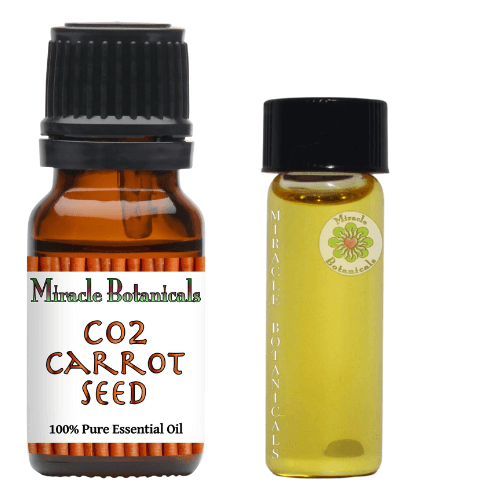
Extraction Method
Supercritical CO2 extraction of carrot seeds represents the most advanced and complete extraction method available. The process is similar to CO2 extraction of carrot root but uses dried carrot seeds as the starting material.
Key advantages of this method:
- Operates at lower temperatures (30-50°C), preserving thermolabile (heat-sensitive) compounds
- Selective extraction can be fine-tuned by adjusting pressure and temperature
- No solvent residues (CO2 completely evaporates)
- Captures both volatile and some non-volatile compounds
- Produces a more complete phytochemical profile
Chemical Composition
CO2-extracted carrot seed oil contains a broader spectrum of compounds compared to steam distillation:
Shared with Steam-Distilled Oil:
- Carotol, daucol, and other sesquiterpene alcohols
- β-Bisabolene and other sesquiterpenes
- Monoterpenes and their oxygenated derivatives
Additional Compounds Captured by CO2 Extraction:
- Higher molecular weight sesquiterpenes: Compounds too heavy to volatilize during steam distillation
- Fatty acids: Small amounts of oleic and linoleic acids from the seed oil
- Tocopherols (vitamin E): Fat-soluble antioxidants
- Carotenoids: Trace amounts that give the CO2 extract a slightly deeper color
- Sterols and waxes: Additional lipophilic compounds with skin benefits
- Flavonoid derivatives: Potent antioxidants destroyed by heat in steam distillation
The result is a more viscous, aromatic, and therapeutically complete oil.
Therapeutic Properties & Enhanced Benefits
The CO2 extract offers all the benefits of steam-distilled carrot seed oil, plus:
Enhanced Antioxidant Activity:The presence of tocopherols, carotenoids, and preserved flavonoid compounds creates a synergistic antioxidant effect more powerful than the steam-distilled version alone.
Broader Spectrum Skin Regeneration:The additional compounds may provide more comprehensive support for skin health, potentially offering enhanced effects on:
- Scar tissue remodeling
- Wound healing
- Collagen and elastin synthesis
- Barrier function repair
Improved Stability:Natural antioxidants extracted alongside the volatile compounds help preserve the oil and extend its shelf life.
More Complex Aromatic Profile:The aroma is richer, more concentrated, and more layered than steam-distilled carrot seed oil, with pronounced earthy, root-like, and slightly sweet notes.
Applications
CO2-extracted carrot seed oil is ideal for:
- Premium anti-aging skincare formulations
- Professional aromatherapy practices
- High-end facial serums targeting multiple signs of aging
- Scar treatment oils and post-surgical care products
- Holistic skincare protocols requiring maximum therapeutic potency
Cost Considerations
CO2 extraction is more expensive than steam distillation due to:
- Higher equipment costs
- More complex operational requirements
- Lower yields in some cases
- Specialized technical expertise needed
As a result, CO2-extracted carrot seed oil typically costs 2-3 times more than the steam-distilled version but offers superior quality and completeness.
Carrot Seed Essential Oil - CO2 Extracted (Daucus Carota)
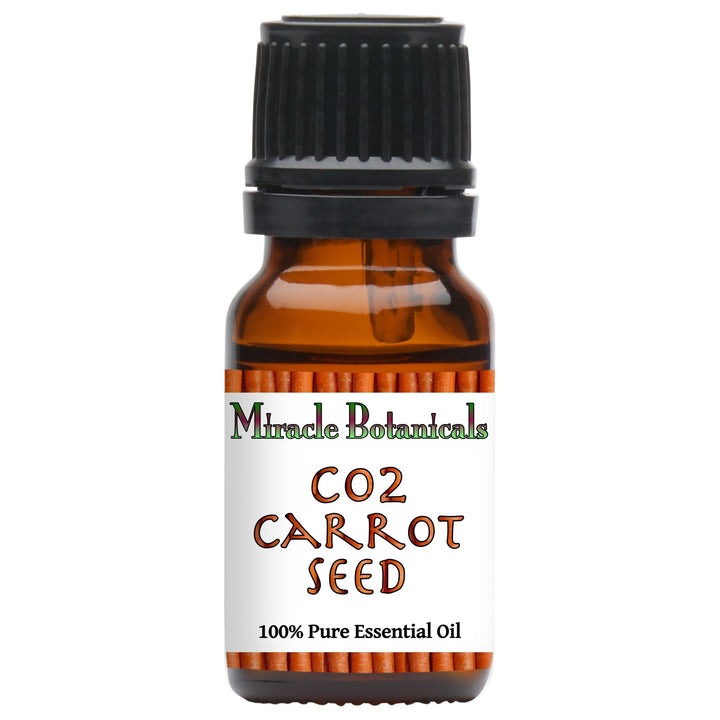
$12.97
Botanical Name: Daucus Carota Plant Part: Seeds Method of Extraction: CO2 Extracted Country of Origin: China Color/Consistency: Yellow to Amber Color with Medium Consistency Aroma: Dry, Slightly Sweet, Earthy Perfumery Note: Middle Main Chemical Components: Carotol (47.53%), Oleic Acid (9.67%), Daucol (5.94%), Geranyl Acetate… read more
Comparative Analysis: Which Oil for Which Purpose?
| Characteristic | Carrot Seed Essential Oil (Steam-Distilled) | Carrot Root Oil (CO2 Extract) | Carrot Seed Essential Oil (CO2 Extracted) |
|---|---|---|---|
| Extraction Temperature | 212-248°F | 95-122°F | 86-122°F |
| Key Constituents | Carotol (30-70%), daucol, β-bisabolene | β-Carotene, α-carotene, vitamin E, lycopene | Carotol, daucol + tocopherols, fatty acids, heavier sesquiterpenes |
| Aromatic Profile | Sweet, earthy, woody, herbaceous | Subtle, earthy, slightly sweet | Intense earthy-sweet, complex |
| Primary Skin Benefits | Rejuvenation, regeneration, tone & elasticity improvement | Antioxidant protection, moisturization, photoaging defense | All steam-distilled benefits + enhanced antioxidant & regenerative effects |
| Best For | Anti-aging, wrinkle reduction, skin balance, cellular renewal | Deep nourishment, sun damage repair, complexion enhancement, dry skin | Premium anti-aging, comprehensive skin regeneration, scar treatment |
| Aromatherapy Use | Grounding, centering, mental clarity | Limited (primarily skincare) | Grounding, emotional balance, meditation (premium grade) |
| Relative Cost | Moderate | Moderate to high | High |
| Ideal Applications | Facial serums, anti-aging creams, aromatherapy blends | Body oils, facial oils, sun-care support, moisturizers | Luxury skincare, professional treatments, intensive repair serums |
| Notable Unique Properties | Classic regenerative essential oil, traditional use | Highest carotenoid content, pro-vitamin A activity | Most complete phytochemical profile, maximum potency |
Synergistic Blending: Using All Three Together
Complementary Mechanisms of Action
Multi-layered antioxidant protection: Steam-distilled carrot seed oil provides volatile antioxidants, carrot root oil delivers carotenoids and vitamin E, while CO2 carrot seed offers both, creating comprehensive free radical defense.
Complete regenerative support: The volatile sesquiterpenes in both seed oils stimulate cellular activity, while the fat-soluble nutrients in carrot root oil provide the building blocks for healthy skin structure.
Surface and deep action: Essential oils work at the skin surface and penetrate to deeper layers, while carrot root oil's lipophilic nutrients integrate into the skin barrier and provide sustained nourishment.
Sample Synergistic Formula: Ultimate Carrot Anti-Aging Serum
Base (70%):
- 50% Jojoba oil (non-comedogenic, stable)
- 20% Rosehip seed oil (additional vitamin A, essential fatty acids)
Carrot Oil Blend (20%):
- 10% Carrot root CO2 extract
- 5% CO2-extracted carrot seed oil
- 5% Steam-distilled carrot seed essential oil
Additional Actives (10%):
- 5% Sea buckthorn oil (additional carotenoids, omega-7)
- 3% Vitamin E (tocopherol, preservative)
- 2% Helichrysum Italicum essential oil (additional regenerative properties)
To use: Apply 3-5 drops to cleansed, damp skin morning and evening. Follow with moisturizer if needed.
Expected Benefits from Tri-Carrot Approach:
- Reduction in fine lines and wrinkles (4-8 weeks)
- Improved skin elasticity and firmness (6-12 weeks)
- Enhanced skin tone and reduced hyperpigmentation (8-16 weeks)
- Accelerated scar fading (3-6 months of consistent use)
- Overall improvement in skin texture and radiance
- Protection against environmental stressors and photoaging
Conclusion: The Power of Informed Choice
Understanding the nuances between steam-distilled carrot seed essential oil, carrot root oil, and CO2-extracted carrot seed essential oil empowers you to make informed decisions for your skincare and wellness practices.
Choose steam-distilled carrot seed oil when:
- You want a traditional, proven essential oil for anti-aging
- Aromatherapy benefits are important
- You need a moderate-cost option with excellent results
- You're creating lighter facial serums or lotions
Choose carrot root oil when:
- Maximum antioxidant protection is the priority
- You need deep moisturization for very dry or sun-damaged skin
- You want pro-vitamin A activity without synthetic retinoids
- Cost-effectiveness is important
- You're working with sensitive skin that prefers non-volatile oils
Choose CO2-extracted carrot seed oil when:
- You want the most complete therapeutic profile
- Premium, professional-grade results are desired
- Budget allows for higher investment
- You're targeting stubborn scars or significant photoaging
- You appreciate the most complex, authentic aroma
Consider using all three when:
- You're creating ultimate anti-aging formulations
- Addressing multiple skin concerns simultaneously (wrinkles, elasticity, scars, tone, dryness)
- You want synergistic, multi-dimensional skin benefits
- You're developing professional skincare protocols
Each oil brings unique strengths to skincare and aromatherapy. By understanding their differences and synergies, you can harness the full regenerative and protective power of Daucus carota – transforming your skin health from root to seed.
Ready to experience the transformative power of carrot oils? Explore our selection of certified organic, therapeutically-tested carrot seed and carrot root oils – each batch tested for purity and potency.
FAQs
Which carrot oil is best for healing wrinkles?
CO2-extracted carrot seed essential oil is the most effective for wrinkles due to its complete phytochemical profile with collagen-stimulating sesquiterpenes and antioxidant tocopherols. However, steam-distilled carrot seed essential oil offers excellent wrinkle-fighting results at a more affordable price, with its high carotol content (30-70%) stimulating fibroblast activity and collagen synthesis.
For maximum results, combine all three carrot oils in a synergistic blend. The volatile sesquiterpenes from both seed oils stimulate collagen production, while carrot root CO2 extract provides antioxidant protection and pro-vitamin A to reduce existing wrinkles and prevent new ones. This approach addresses wrinkles from multiple angles—delivering visible results within 4-8 weeks.
Does carrot seed oil boost collagen production?
Yes! Hallelujah! Carrot seed essential oil contains sesquiterpene alcohols like carotol and daucol that stimulate fibroblast activity—the cells responsible for producing collagen and elastin in your skin.
How it works: These sesquiterpenes signal fibroblasts to increase collagen synthesis, helping to firm skin, reduce wrinkles, and improve elasticity. Carrot root CO2 extract supports this by providing antioxidant protection against collagen-degrading free radicals and pro-vitamin A for healthy skin cell turnover.
For visible improvements in skin firmness, use carrot seed oil consistently for 6-12 weeks—the time needed for new collagen formation. Combining it with rosehip seed oil & frankincense essential oil enhances collagen-boosting results even further.


